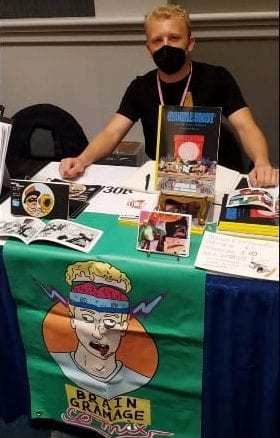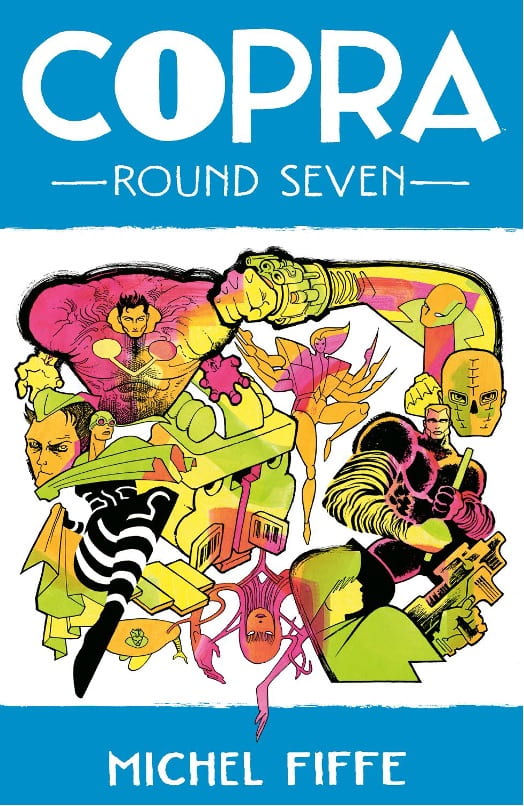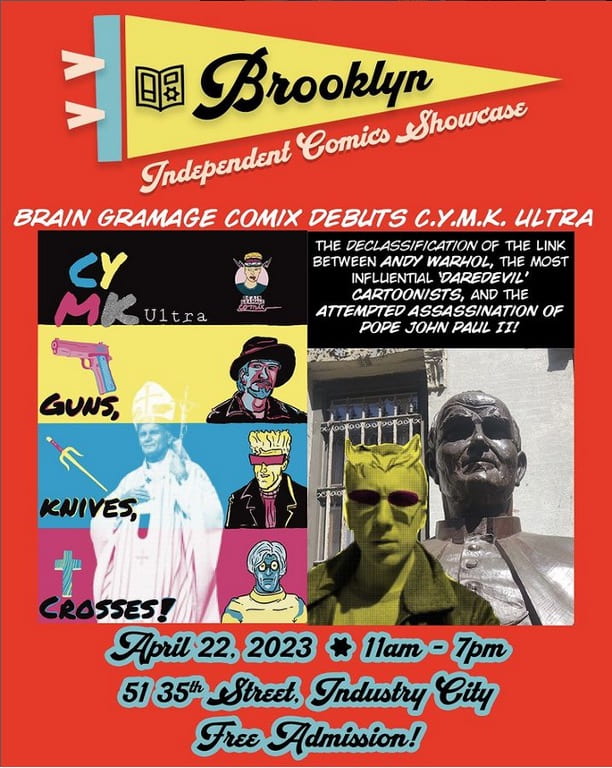By Zoey Joseph, UP Outreach Coordinator, and Alison Jaenicke, KLIO Faculty Advisor ∼
“Brain Gramage Comix” is a publishing imprint from the self-proclaimed “Gramaged” brain of Graham Millar, who graduated from Penn State University in 2021, shortly after serving as the Art Coordinator for KLIO and overseeing the inaugural publication of comics within our creative arts journal.

Graham Millar Credit: insta_graham_millar on
Instagram
Graham began self-publishing in February 2020 with his first mini-comic, “Mozzarella: A Rumble in the Jungle.”
As part of KLIO 2021, he published an original comic, “Plant Presents ‘Lunch Break’,” and he wrote about the process of creating comics in a feature post entitled “The Viper Crash’ Process Breakdown.”
In March of 2022, Graham completed his first 100+ page graphic novel, “Knuckle Headz Book 1,” the first chapter of which is available to read for free on his site.
Since then, he has entered the field of professional comics by providing production assistance and media services to Living the Line Books on a freelance basis and has exhibited his comics at expos and retail locations throughout the Northeast United States.

Graham Millar promoting “Brain Gramage Comix.” Credit: insta_graham_millar on
Instagram
We asked Graham to fill us in on what he’s been doing since graduation in 2021 and to offer some tips and advice to aspiring comics artists; here are his emailed responses to our questions:
Zoey Joseph: What most excites you about writing comics?
Graham Millar: I think what excites me about writing comics is being able to develop a whole package of information. There’s more to it than just trying to tell an engaging story–it’s really a whole portfolio of ideas. Page design is just as important as the narrative and when you can find a way to import the mood of the narrative into the presentation of the sequence of events, it really feels like you’re presenting the audience with something that can’t be done with just images or text alone.
ZJ: What themes or topics inspire you, and how do you explore them in your comics?
GM: I’ll be honest, the first 200 or so pages of comics I’ve drawn can most intelligently be described as “action figure manifestos.” They were really just a training exercise to push myself to be able to draw comics better on every level. I tried to push myself in terms of drawing challenging settings, different body types, and strong compositions, but at the end of the day, the story I was producing was little more than a series of set-ups for G.I. Joe toys that only exist in my brain to smash into each other.
With the most recent comic I’ve been working on, “C.Y.M.K. Ultra: Guns, Knives, and Crosses,” I’ve expanded a little beyond this juvenile motivation for creation. “C.Y.M.K. Ultra” is a comic about the formation and danger of ideas. Ideas are precious and they are dangerous.
Grant Morrison, one of my favorite comic book writers, loves to say “before the bomb was the bomb, it was just an idea.” I think about that quote a lot, especially in terms of comics, because when you have someone writing and drawing their own book, it really can feel like you’re following an entire train of thought that’s rattling along a track directly out of their head onto the page.
I know you can say this about writing, but the way someone renders the people and places in their own hand feels like a more intimate and unpolished look into how they view the world.
ZJ: Who are some of your biggest artistic influences, and how have they shaped your style and approach to comics?
GM: This should feel like the easiest question in the world but I’m in too deep to have an easy answer. Scott McCloud is an obvious one. People probably know him from “Understanding Comics.” I think it’s really fun to read his Sci-fi series, “ZOT!” after reading “Understanding Comics” because you can see him piecing together the puzzle of describing comics as if they were a technical manual in the pages of “ZOT!.” It’s good to understand things on a technical level, but sometimes you have to see those ideas in action to really judge them.
I’m also unofficially Michel Fiffe‘s biggest fan. At one point during quarantine, I gave myself a stick and poke tattoo of the skull logo from his comic “COPRA.” “COPRA” was an action comic that looked like nothing else I’d ever seen before. From the first page that I read, I basically wished I had made that comic. I spent the next two years putting together my 100-page comic, “Knuckle Headz,” as an attempt to fulfill that wish.
The difference between “Knuckle Headz” and “COPRA” is that Fiffe knew how to put heart into his action figures. There’s a raw quality to both “ZOT!” and “COPRA” that gives you a sense that you won’t know how to do something right until you actually try to do it. Comics are a pretty easy medium to experiment in. You can try to lay out something on notebook paper and in five minutes know whether or not it will work.

Michel Fiffe’s comic “COPRA” Credit: Michel Fiffe
ZJ: Where do you find a comics community and how do you connect and interact with others in the community?
GM: I’m still working on finding a comics community, although it feels like I’m stepping in the right direction. Last year I did some freelance work for the publisher Living the Line after simply emailing the publisher, Sean Robinson, and asking if he needed a production assistant. This doesn’t always work, but Sean pretty much runs a one-man show, and he was gracious enough to show me some of the ropes in professional comics.
I got my first lettering jobs in the English language editions of Yokoyama Yuichi’s “Plaza”, and Erik Kriek’s “The Exile” thanks to Sean. “The Exile” was especially exciting to me because I was familiar with Kriek’s work before working on one of his books. I was even fortunate enough to meet him last weekend at MoCCA Arts Fest [Manhattan’s largest independent comics & cartoon festival] following the release of the book. I was pretty shocked he attended, as he lives in the Netherlands.
Some of my coworkers at my new job working for Yen Press make their own comics, although only being required in the physical office once a week hasn’t allowed me to discuss with them as I would like to. I’m meeting other creators at pop-up zine fests and mid-size conventions.
I made a decent number of friends at the Small Press Expo, who I regularly communicate with online, but we’re all kind of spread out. They publish the “Xomik Buk” anthology together, a publication which I haven’t yet had a chance to contribute to but highly recommend. I’m hoping that I’ll be able to make some more local connections at BICS (Brooklyn Independent Comics Showcase) in just a few short weeks, and then some more at Brooklyn Comic Con in June.

Poster for C.Y.M.K. at Brooklyn Comic Con. Credit: insta_graham_millar on
Instagram
ZJ: What projects are you most proud of and what projects are you currently working on?
GM: There are things I’m proud of in all my comics, but until I put together C.Y.M.K.Ultra I think the parts I should have been embarrassed about far outweighed what I should have been proud of. I don’t regret drawing a single page of my older comics. As I said, I drew 200-some pages of comics just to figure out how to do it right.
I have a really good feeling about “C.Y.M.K. Ultra.” It is a showcase of my best storytelling chops. The story is ridiculous, but it’s still pretty personal. It’s a fictionalized account of the attempted assassination of Pope John Paul II. Cartoonists have been made into sleeper agents by the CIA to perform the dirty deed, hence the title. C.M.Y.K. is the acronym for printer color designations. MK Ultra was an actual program the CIA ran, experimenting in brainwashing and information extraction.
“Guns, Knives, and Crosses” is the title of an Andy Warhol piece which just happened to sound a lot like a never-made Frank Miller comic. His comic “Sin City: Bullets, Booze, and Broads” in particular, feels like it would preclude a book titled “Guns, Knives, and Crosses.” Mix in a little Catholic guilt, and two highly disparate interests in Silver Age comics, and Frank and Andy become good narrative foils for each other.
I’m rambling here but I hope it contextualizes the concept of Andy Warhol engaging in a martial arts showdown in Vatican City.
ZJ: What advice would you give to aspiring comics creators who are just starting out or trying to break into the industry?
GM: The best advice I can give to someone trying to break in is to just keep finishing projects. Comics is a small world; if you make enough noise someone will start to listen. It might not be a major publisher contracting you for a series of graphic novels, but employment opportunities exist if you look for them, and you can show them something concrete.
I’m not going to lie, I barely sell my own books, but the work I do in the field of professional comics is expanding. There are a lot of skills you can learn on the production end rather than the artistic end that is transferable to work that’s more marketable.
Everybody’s path is different. I’m sure there are artists more talented than me reading this right now, and in that case, trying to talk to publishers at conventions might not be a bad move. Smaller publishers like Field Mouse Press do have periods where they open up submissions for creator-owned work.
I’m happy producing comics in my free time. I’d like the actual drawing to be my job, but at the end of the day, it doesn’t matter if it is or not because it’s my vocation. The starving artist is a myth that’s glamorized a lot, but I don’t really see why. It’s hard for me to make art if I’m miserable.
I don’t know how to break into actually making comics for a living, but I’m pretty happy with the compromise of working on comics for a living, and making comics because I eat, sleep, and breathe comics. That might make me sound robotic, but I’ve always liked robots.
Follow Graham/Brain Gramage Comix on Instagram: @insta_graham_millar
 Zoey Joseph’s position for KLIO is the University Park Outreach and Initiatives. She is currently a second-year majoring in advertising. Outside of KLIO, she is a part of VALLEY magazine’s advertising team, as well as a member of Phi Sigma Sigma and fundraising specialist for her THON committee.
Zoey Joseph’s position for KLIO is the University Park Outreach and Initiatives. She is currently a second-year majoring in advertising. Outside of KLIO, she is a part of VALLEY magazine’s advertising team, as well as a member of Phi Sigma Sigma and fundraising specialist for her THON committee.